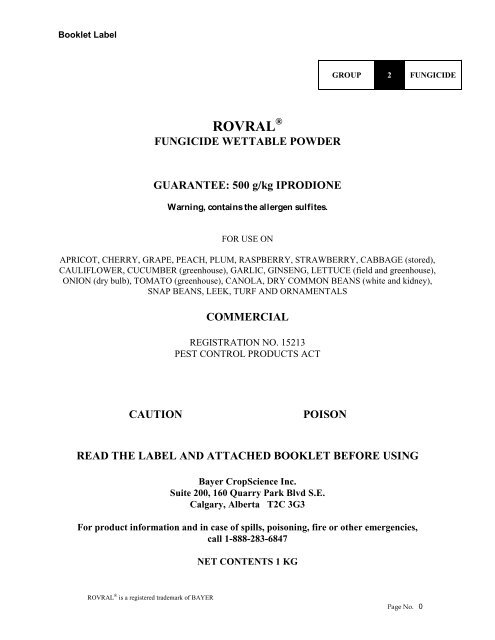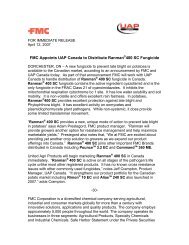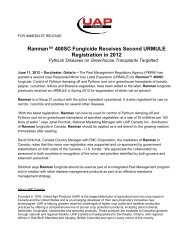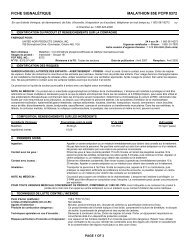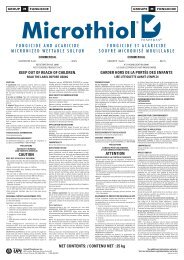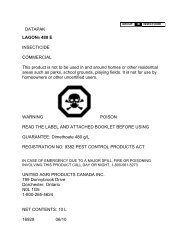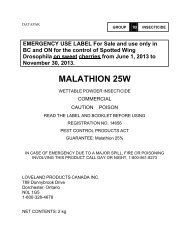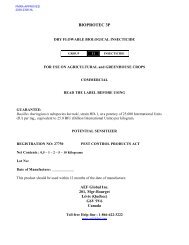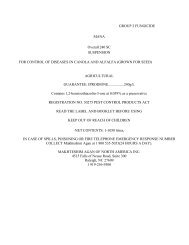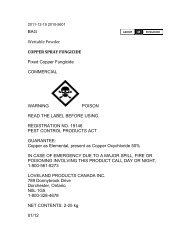rovral - UAP
rovral - UAP
rovral - UAP
You also want an ePaper? Increase the reach of your titles
YUMPU automatically turns print PDFs into web optimized ePapers that Google loves.
Booklet Label<br />
GROUP 2 FUNGICIDE<br />
ROVRAL ®<br />
FUNGICIDE WETTABLE POWDER<br />
GUARANTEE: 500 g/kg IPRODIONE<br />
Warning, contains the allergen sulfites.<br />
FOR USE ON<br />
APRICOT, CHERRY, GRAPE, PEACH, PLUM, RASPBERRY, STRAWBERRY, CABBAGE (stored),<br />
CAULIFLOWER, CUCUMBER (greenhouse), GARLIC, GINSENG, LETTUCE (field and greenhouse),<br />
ONION (dry bulb), TOMATO (greenhouse), CANOLA, DRY COMMON BEANS (white and kidney),<br />
SNAP BEANS, LEEK, TURF AND ORNAMENTALS<br />
COMMERCIAL<br />
REGISTRATION NO. 15213<br />
PEST CONTROL PRODUCTS ACT<br />
CAUTION<br />
POISON<br />
READ THE LABEL AND ATTACHED BOOKLET BEFORE USING<br />
Bayer CropScience Inc.<br />
Suite 200, 160 Quarry Park Blvd S.E.<br />
Calgary, Alberta T2C 3G3<br />
For product information and in case of spills, poisoning, fire or other emergencies,<br />
call 1-888-283-6847<br />
NET CONTENTS 1 KG<br />
ROVRAL ® is a registered trademark of BAYER<br />
Page No. 0
Booklet Label<br />
PRECAUTIONS:<br />
KEEP OUT OF REACH OF CHILDREN.<br />
During all activities, wear long pants, long-sleeved shirt and work boots. In addition, chemical<br />
resistant gloves, protective eyewear and work boots must be worn during mixing, loading,<br />
cleanup and repair of spray equipment.<br />
For aerial application, coveralls or a chemical resistant apron over normal work clothes, chemical<br />
resistant gloves, protective eyewear and work boots must be worn during mixing and loading<br />
operations.<br />
DO NOT re-enter treated areas within 12 hours. If required, individuals may re-enter treated<br />
areas within 12 hours for short-terms tasks not involving hand labour if at least 4 hours have<br />
passed since application and long pants, long-sleeved shirt, hat, protective eyewear and chemical<br />
resistant gloves are worn.<br />
Do not inhale product or spray. This product is mildly irritating to eyes. Wash hands and<br />
exposed skin before eating, drinking or smoking. Thoroughly clean application equipment after<br />
use. Do not contaminate domestic or irrigation waters. Do not store in contact with foodstuffs.<br />
If this pest control product is to be used on a commodity that may be exported to the U.S.<br />
and you require information on acceptable residue levels in the U.S., visit CropLife Canada’s<br />
web site at: www.croplife.ca.<br />
CAUTION: Do not graze the treated crops or use for feed or fodder; sufficient data are not<br />
available to support such use.<br />
AIR APPLICATION<br />
• Apply only by fixed-wing or rotary aircraft equipment which has been functionally and<br />
operationally calibrated for the atmospheric conditions of the area and the application rates<br />
and conditions of this label.<br />
• Label rates, conditions and precautions are product specific. Read and understand the entire<br />
label before opening this product. Apply only at the rate recommended for aerial application<br />
on this label. Where no rate for aerial application appears for the specific use, this product<br />
cannot be applied by any type of aerial equipment.<br />
• Ensure uniform application. To avoid streaked, uneven or overlapped application, use<br />
appropriate marking devices.<br />
Aerial Use Precautions<br />
• Read and understand the entire label before opening this product. If you have questions, call<br />
Bayer CropScience Inc. at 1-888-283-6847 or obtain technical advice from the distributor or<br />
your provincial agricultural representative.<br />
• Apply only when meteorological conditions at the treatment site allow for complete and even<br />
crop coverage. Apply only under conditions of good practice specific to aerial application as<br />
outlined in the National Aerial Pesticide Application Manual, developed by the<br />
Federal/Provincial/Territorial Committee on Pest Management and Pesticides.<br />
• Do not apply to terrain where there is a potential for surface run-off to enter aquatic systems.<br />
Page No. 1
Booklet Label<br />
• Do not apply if rain is expected within 1 hour after spraying. If tank mixing, consult<br />
the tank mix partner label and respect the most restrictive interval.<br />
Aerial Application Operator Precautions<br />
• Do not allow the pilot to mix chemicals to be loaded onto the aircraft. Loading of premixed<br />
chemicals with a closed system is permitted.<br />
• It is desirable that the pilot has communication capabilities at each treatment site at the time<br />
of application.<br />
• The field crew and the mixer/loaders must wear chemical resistant gloves, coveralls and<br />
goggles or face shield during mixing/loading, cleanup and repair. Follow the more stringent<br />
label precautions in cases where the operator precautions exceed the generic label<br />
recommendations on the existing ground boom label.<br />
• All personnel on the job site must wash hands and face thoroughly before eating and<br />
drinking. Protective clothing, aircraft cockpit and vehicle cabs must be decontaminated<br />
regularly.<br />
FIRST AID:<br />
If on skin or clothing, take off contaminated clothing. Rinse skin immediately with plenty of<br />
water for 15-20 minutes. Call a poison control centre or doctor for treatment advice.<br />
If in eyes, hold eye open and rinse slowly and gently with water for 15-20 minutes. Remove<br />
contact lenses, if present, after the first 5 minutes, then continue rinsing eye. Call a poison<br />
control centre or doctor for treatment advice.<br />
If swallowed, call a poison control centre or doctor immediately for treatment advice. Have<br />
person sip a glass of water if able to swallow. Do not induce vomiting unless told to do so by a<br />
poison control centre or doctor. Do not give anything by mouth to an unconscious person.<br />
If inhaled, move person to fresh air. If person is not breathing, call 911 or an ambulance, then<br />
give artificial respiration, preferably by mouth-to mouth, if possible. Call a poison control centre<br />
or doctor for further treatment advice.<br />
Take container, label or product name and Pest Control Product Registration Number with you<br />
when seeking medical attention.<br />
TOXICOLOGICAL INFORMATION:<br />
Treat symptomatically. Medical personnel should contact Bayer CropScience’s medical<br />
information services, toll-free 1-800-334-7577.<br />
DISPOSAL:<br />
1. Empty bag.<br />
2. Follow provincial instructions for any required additional cleaning of the bag prior to its<br />
disposal.<br />
3. Make the empty bag unsuitable for further use.<br />
4. Dispose of the bag in accordance with provincial requirements.<br />
5. For information on the disposal of unused, unwanted product, contact the manufacturer or<br />
provincial regulatory agency. Contact the manufacturer and the provincial regulatory agency<br />
in case of a spill, and for cleanup of spills.<br />
NOTICE TO USER: This control product is to be used only in accordance with the directions<br />
on this label. It is an offence under the Pest Control Products Act to use this product in a way<br />
Page No. 2
Booklet Label<br />
that is inconsistent with the directions on the label. The user assumes the risk to persons or<br />
property that arises from any such use of this product.<br />
DIRECTIONS FOR USE:<br />
For application through field, aerial or orchard sprayers, put one half the required water volume<br />
in the tank, stir in Rovral ® and add the remainder of the water. For use through knapsack or<br />
small sprayers, first stir the required amount of Rovral ® with water in a bucket, add this<br />
suspension to the partly filled spray tank, then add the remainder of the water.<br />
Ensure mixing is complete and agitate thoroughly before each application and continue to agitate<br />
during spraying.<br />
A prepared spray mixture should be used as soon as possible in the same day, especially if the<br />
water used for mixing is alkaline (greater than pH of 7).<br />
Rovral ® should not be mixed with other pesticides, adjuvants or fertilizers except where stated.<br />
FRUIT AND FIELD CROPS<br />
APRICOT- CONTROL OF BROWN ROT/BLOSSOM BLIGHT<br />
RATE: 1.5 kg/ha of Rovral ® .<br />
TIMING: To protect the fruit use Rovral ® in a cover spray program with application at 7-14 day<br />
intervals throughout the season. Use the short term interval under wet conditions close to harvest.<br />
For blossom blight apply at first bloom. Repeat at 4-5 day intervals if weather is wet. Apply by<br />
ground. Observe a 1 day PHI. To reduce the possibility of disease resistance to Rovral ® ,<br />
alternation with other fungicides is recommended.<br />
CHERRY - CONTROL OF BROWN ROT<br />
RATE: 1.5-1.75 kg/ha of Rovral ® . Use the higher rate on large or mature trees. For dilute<br />
sprays use 50 g/100 litres of water.<br />
TIMING: Blossom Blight Stage: Spray at first bloom. If wet weather prevails, this spray<br />
should be repeated.<br />
Brown Rot: To protect the fruit use Rovral ® in a spray program with applications beginning at<br />
Shuck. Repeat at 7-14 day intervals throughout the season, including a treatment 1 day prior to<br />
harvest. To reduce the possibility of disease resistance to Rovral ® , the alternation with other<br />
fungicides is recommended.<br />
GRAPE - CONTROL OF BOTRYTIS BUNCH ROT<br />
RATE: 1.5 kg/ha Rovral ® in at least 900 litres of water per hectare.<br />
TIMING: Sprays may be applied beginning at mid to late bloom. Two sprays should be applied<br />
before complete bunch closure; these should be timed to achieve maximum protection of the<br />
Page No. 3
Booklet Label<br />
fruit, i.e. just before anticipated periods of wet weather. To reduce the possibility of disease<br />
resistance to Rovral ® , no more than two applications of Rovral ® should be made per season;<br />
other fungicides should be alternated with Rovral ® in a bunch rot control program.<br />
PEACH - CONTROL OF BROWN ROT<br />
RATE: 1.5-1.75 kg/ha of Rovral ® . Use the higher rate on large or mature trees. For dilute<br />
sprays, use 50 g/100 litres of water.<br />
TIMING: Blossom Blight: Spray at first bloom to control blossom blight stage of brown rot.<br />
Repeat at 4-5 day intervals if the weather is wet.<br />
Brown Rot: To protect the fruit use Rovral ® in a cover spray program with application at 7-14<br />
day intervals throughout the season including a treatment 1 day prior to harvest. Use the short<br />
interval under wet conditions close to harvest. To reduce the possibility of disease resistance to<br />
Rovral ® , the alternation with other fungicides is recommended.<br />
PLUM/PRUNE - CONTROL OF BROWN ROT<br />
RATE: 1.5 kg/ha of Rovral ® .<br />
TIMING: To protect the fruit use Rovral ® in a cover spray program with application at 7-14 day<br />
intervals throughout the season. Use the short interval under wet conditions close to harvest.<br />
Observe a 1 day PHI. Apply by ground. To reduce the possibility of disease resistance to<br />
Rovral ® , alternation with other fungicides is recommended.<br />
RASPBERRY - CONTROL OF GREY MOLD FRUIT ROT<br />
RATE: 2 kg/ha of Rovral ® in 1000 litres of water per hectare.<br />
TIMING: Apply a maximum of 8 applications per year. Begin applications when flower buds<br />
are visible in the crown and repeat at 7-10 day intervals. Reduce intervals during rainy periods.<br />
Apply by ground. Observe a 1 day PHI. To reduce the possibility of disease resistance to<br />
Rovral ® , alternation with other fungicides is recommended.<br />
STRAWBERRY - CONTROL OF BOTRYTIS FRUIT ROT<br />
AND SUPPRESSION OF PENICILLIUM<br />
RATE: 2 kg/ha of Rovral ® in at least 1000 litres of water per hectare. Good coverage of the<br />
plants is essential. The addition of a non-ionic adjuvant registered for this purpose will improve<br />
performance.<br />
TIMING: Begin application when flower buds are visible in the crown and repeat at 7-10 day<br />
intervals. Reduce interval during rainy periods. To reduce the possibility of disease resistance to<br />
Rovral ® , the alternation with other fungicides is recommended. Leave 1 day from last spray to<br />
harvest.<br />
Page No. 4
Booklet Label<br />
CABBAGE (STORED) - CONTROL OF ALTERNARIA<br />
RATE: 3 kg/ha of Rovral ® .<br />
TIMING: Make 1 application 7-14 days before harvest. Apply by ground; boom or airblast<br />
sprayer. Observe a PHI of 7 days.<br />
CAULIFLOWER - CONTROL OF ALTERNARIA<br />
RATE: 3 kg/ha of Rovral ® .<br />
TIMING: Make 1 application 1-2 days prior to tying. Apply by ground; boom or airblast<br />
sprayer. Observe a PHI of 5 days.<br />
CUCUMBER (GREENHOUSE) - CONTROL OF GUMMEY STEM BLIGHT<br />
RATE: 100g Rovral®/100 L water applied at 1000-2000 L water per hectare. Spray to run-off<br />
ensuring good coverage of the plants, particularly stem nodes, immediately following any<br />
pruning.<br />
TIMING: Begin application at the first sign of disease. Spray at weekly intervals or as required<br />
for control. Observe a PHI of 2 days.<br />
CUCUMBER (GREENHOUSE) - CONTROL OF BOTRYTIS GREY MOLD<br />
RATE: 100g Rovral®/100 L water per hectare. Spray to run-off ensuring good coverage of the<br />
plants particularly stem nodes immediately following any pruning.<br />
TIMING: Begin application at the first sign of disease. Spray at weekly intervals or as required<br />
for control. At least 2 days must elapse between treatment and picking. To reduce the possibility<br />
of disease resistance, Rovral® must be alternated with other fungicides.<br />
GARLIC - CONTROL OF GREEN MOLD (Penicillium corymbiferum)<br />
RATE: 4g/L Rovral ® as a seed dip.<br />
TIMING: Dip garlic seeds for 30 minutes in a suspension of Rovral ® and water. Make one<br />
application in the fall, immediately before planting.<br />
GINSENG - CONTROL OF ALTERNARIA LEAF BLIGHT<br />
RATE: 1.1 Kg/ha Rovral ® in at least 2000 L of water per hectare.<br />
TIMING: Apply when the disease first appears and follow with two subsequent sprays at<br />
monthly intervals as part of a spray programme. Do not apply more than three applications per<br />
season; the Rovral ® applications should be alternated with other suitable fungicides. Do not<br />
apply closer than 30 days to harvest.<br />
Page No. 5
Booklet Label<br />
LETTUCE (FIELD)- CONTROL OF GREY MOLD<br />
RATE: 1.5 kg/ha of Rovral ® in 300-500 L water per hectare.<br />
TIMING: Apply a maximum of 4 applications per year at 7 day intervals between sprays.<br />
Apply by ground; boom sprayer. Observe a PHI of 4 days.<br />
LETTUCE (GREENHOUSE) - CONTROL OF GREY MOLD/SCLEROTINIA DROP<br />
RATE: 2 kg/ha of Rovral ® in 2000 L water per hectare. Use a high volume sprayer.<br />
TIMING: Apply a maximum of 4 applications per year with the first application at the 3-leaf<br />
stage and then every 7-10 days if conditions continue to favour disease development. Observe a<br />
PHI of 14 days.<br />
ONION (DRY BULB) - CONTROL OF BOTRYTIS LEAF BLIGHT<br />
RATE: 1.5 kg/ha Rovral ® applied in 300-500 litres of water. The addition of a non-ionic<br />
adjuvant will improve performance.<br />
TIMING: Begin applications about mid-June or at the first sign of leaf spotting and repeat at 7-<br />
10 day intervals.<br />
Do not apply Rovral ® within 15 days of harvest. To reduce the possibility of disease resistance<br />
to Rovral ® , the alternation with other fungicides is recommended.<br />
ONIONS (DRY BULB) - CONTROL OF BOTRYTIS LEAF BLIGHT PLUS DOWNY<br />
MILDEW<br />
RATE: Use 0.75 kg/ha Rovral ® tank-mixed with the recommended rate of Manzate DF<br />
Fungicide or Manzate Pro-Stick Fungicide for downy mildew control (consult the Manzate DF<br />
Fungicide or Manzate Pro-Stick Fungicide label for dose rates, precautions and limitations).<br />
Apply in 300-500 litres of water per hectare. The addition of a non-ionic adjuvant will improve<br />
performance.<br />
TIMING: Apply this tank-mix as a preventative treatment. Application can begin mid-June or<br />
when conditions are favourable for disease infection. Repeat applications at 7-10 day intervals.<br />
DO NOT apply Rovral ® within 15 days of harvest.<br />
TOMATO (GREENHOUSE) - CONTROL OF BOTRYTIS GREY MOLD<br />
RATE: 100 g Rovral ® /100 L water. Spray to run-off ensuring good coverage of the plants,<br />
particularly stem nodes immediately following any pruning.<br />
TIMING: Treat when the second truss is in flower or at the onset of the disease. Repeat<br />
treatment at weekly intervals or when conditions are favourable.<br />
At least 2 days must elapse between treatment and picking. To reduce the possibility of disease<br />
resistance, Rovral ® must be alternated with other fungicides.<br />
Page No. 6
Booklet Label<br />
CANOLA - CONTROL OF SCLEROTINIA STEM ROT<br />
RATE: 1-1.5 kg/ha Rovral ® as an aerial application in at least 45 litres of water per hectare. The<br />
use of the higher rate is recommended for fields with a history of heavy disease pressure or for<br />
dense crop stands. Good coverage of the plants is essential.<br />
The addition of a non-ionic adjuvant will improve performance.<br />
TIMING: Apply Rovral ® when 20-30% of the blooms have opened.<br />
DRY COMMON BEANS (WHITE & KIDNEY) - CONTROL<br />
OF SCLEROTINIA WHITE MOLD<br />
RATE: 1-1.5 kg/ha Rovral ® . The use of the higher rate is recommended for fields with a history<br />
of heavy disease pressure or for dense crop stands. For ground application use 300 litres of water<br />
per hectare. For aerial application, use at least 45 litres of water per hectare. Good coverage of<br />
the foliage and stems is essential. To ensure thorough coverage for ground applications, a<br />
combination of overhead and drop nozzles should be used at a minimum pressure of 400 kPa.<br />
The addition of a non-ionic adjuvant will improve performance.<br />
TIMING: Apply Rovral ® as a preventative treatment when 25-75% of the blooms have opened.<br />
Treatment prior to the presence of disease is preferable, but Rovral ® is still effective if<br />
application is made at the initial sign of disease infection, when less than 5% of the plants are<br />
showing white mold.<br />
SNAP BEANS - CONTROL OF SCLEROTINIA WHITE MOLD<br />
AND BOTRYTIS POD ROT<br />
RATE: 1.5 kg/ha of Rovral ® in 300 litres of water per hectare for ground applications and at<br />
least 45 litres of water for aerial application. Good coverage of the plants is essential. The<br />
addition of a non-ionic adjuvant registered for this purpose will improve performance.<br />
TIMING: Control of Sclerotinia white mold - apply Rovral ® when 50% of the blooms have<br />
opened. Control of Botrytis pod rot (normally only a problem in British Columbia) - apply<br />
Rovral ® twice, when 30% and again when 50% of the blooms have opened.<br />
CARROT SEED - CONTROL OF SEED BORNE ALTERNARIA<br />
RATE: 521 mL of Rovral ® /100 kg seed<br />
DIRECTIONS: For the importation of treated seed into Canada; NO SEED IS TO BE<br />
TREATED IN CANADA:<br />
Wear protective gloves and overalls when handling treated seeds. When augering or handing<br />
treated seed work in a well ventilated area and wear a suitable respirator.<br />
Page No. 7
Booklet Label<br />
NOTE TO USER: READ THE FOLLOWING BEFORE USING THIS PRODUCT FOR<br />
THE INDICATED SPECIAL USE APPLICATIONS (BELOW): The DIRECTIONS FOR<br />
USE for this product for the uses described below were developed by persons other than<br />
Bayer CropScience and accepted for registration by Health Canada under the User<br />
Requested Minor Use Label Expansion program. Bayer CropScience itself makes no<br />
representation or warranty with respect to performance (efficacy) or crop tolerance<br />
(phytotoxicity) claims for this product when used on the crops listed below. Accordingly,<br />
the Buyer and User assume all risks related to performance and crop tolerance arising, and<br />
agree to hold Bayer CropScience harmless from any claims based on efficacy or<br />
phytotoxicity in connection with the uses described below.<br />
LEEK – CONTROL OF BOTRYTIS LEAF BLIGHT<br />
Pest: For control of Botrytis leaf blight<br />
Rate: 1.5 kg/ha of Rovral ® applied in 300-500 litres of water as a foliar spray.<br />
Timing: Apply a maximum of 4 applications per year with the first application at the appearance<br />
of the disease and /or when conditions are favourable to the disease prevail. Repeat applications<br />
should be made at 7-10 day intervals. Observe a PHI of 15 days.<br />
TURF AND ORNAMENTALS<br />
TURF<br />
Rovral ® is effective either as a preventative or curative spray. Ensure the area to be treated is<br />
covered uniformly. Apply the required amount of Rovral ® in not less than 10 litres per 100 m 2 .<br />
When treating golf greens, always treat aprons and fairway approaches. Avoid mowing for ten<br />
hours after application.<br />
DOLLAR SPOT (Sclerotinia homeocarpa)<br />
Apply Rovral ® at the first sign of disease and repeat at recommended intervals as long as<br />
required. Use either 30g per 100 m 2 at 14-day intervals or 45 g per 100 m 2 at 21 day intervals.<br />
BROWN PATCH (Rhizoctonia solani)<br />
Apply Rovral ® at 60 to 125 g per 100 m 2 , beginning when the disease is first observed and<br />
continue at 14 to 21 day intervals throughout the season or as needed. Under severe disease<br />
pressure use the higher rate and the shorter interval.<br />
LEAF SPOT, MELTING OUT (Helminthosporium spp.)<br />
Apply Rovral ® at 60 g per 100 m 2 when the disease first appears. Repeat 2 or 3 times in the early<br />
spring at 14 -21 day intervals or as needed.<br />
Page No. 8
Booklet Label<br />
GREY AND PINK SNOW MOLD (Typhula spp. and Fusarium nivale)<br />
To suppress the active stages of the disease during spring or fall, apply Rovral ® at 180g per 100<br />
m 2 . For winter protection, Rovral Green ® is recommended.<br />
ORNAMENTALS - CONTROL OF BOTRYTIS spp.<br />
RATE: 10g Rovral ® per 10 litres of water. Apply to the point of run-off, ensuring good<br />
coverage of the plants.<br />
TIMING: Treat at the onset of Botrytis and repeat at 21 day intervals, or as necessary.<br />
To reduce the possibility of disease resistance, Rovral ® must be alternated with other fungicides.<br />
The following species have been safely treated:<br />
Adiantum spp<br />
Apehlandra squarrosa<br />
Aralia elegantissima<br />
Aralia sieboldii<br />
Asparagus sprengeri<br />
Asparagus plumosus<br />
Azalea spp<br />
Begonia rex var. Fireglow Chrysanthemum<br />
spp<br />
(all year round)<br />
Chlorophytum spp<br />
Cineraria spp<br />
Ciccus antarctica<br />
Croton spp var. Bravo<br />
Cyclamen spp<br />
Dracaena spp var. Rededge<br />
Episcia cupreata<br />
Euonymus spp<br />
Euphorbia splendens<br />
Ficus spp<br />
Fittonia spp<br />
Fuchsia spp<br />
Geranium (Zonal)<br />
Gesneria spp<br />
Gynura sarmentosa<br />
Hedera spp<br />
Hypoestes sanguinolenta<br />
Impatiens spp<br />
Iresine herbstii<br />
Kalanchoe spp<br />
Maranta spp<br />
Monstera deliciosa borsigiana<br />
Neanthe bella<br />
Nepeta (ginger plant)<br />
Nephrolepis spp<br />
Pelargonium spp<br />
Peperomia caperata<br />
Peperomia hederifolia<br />
Peperomia magnoliifolia<br />
Philodendron scandens<br />
Pilea cadierei<br />
Poinsettia spp<br />
Primula spp<br />
Rhoicissus spp<br />
Ruellia makoyana<br />
Saintpaulia ionantha**<br />
Saxifraga stolonifera<br />
Senecio macroglossus variegatum<br />
Setcreasea purpurea<br />
Sinningia spp (Gloxinia)<br />
Solanum capsicastrum<br />
Rosa samantha<br />
** Spraying Saintpaulia flowers may result in petal scorch. Tepid water should be used and the<br />
wet plants protected from direct sunlight.<br />
Page No. 9
Booklet Label<br />
Tolerance of other species should be checked on a few plants before making any large scale<br />
applications.<br />
ORNAMENTALS - CONTROL OF DAMPING-OFF CAUSED<br />
BY RHIZOCTONIA<br />
RATE: 2 g Rovral ® in 5 litres of water applied per square metre as a drench.<br />
TIMING: Treat immediately after picking out when the risk of infection is particularly high.<br />
The following species can be treated: Celosia, Salvia. Tolerance of other species should be<br />
checked on a few plants before making any large scale applications.<br />
CONIFER SEEDLINGS (SPRUCE, FIR, HEMLOCK, CEDAR) - CONTROL OF<br />
BOTRYTIS BLIGHT:<br />
FOR USE ON CONTAINER OR BAREROOT CONIFER SEEDLINGS IN GREENHOUSES<br />
AND CONIFER NURSERIES.<br />
RATE: 1.5-2 kg Rovral ® /ha in 1100 litres of water/ha. (15-20 grams in 11 litres water/100 m 2 )<br />
TIMING: Treat at the onset of botrytis, and repeat at 21 day intervals. Do not apply more than<br />
3 applications of Rovral ® /year. Do not apply 2 days prior to harvest. To reduce the possibility of<br />
disease resistance Rovral ® must be alternated with other suitable fungicides.<br />
RESISTANCE MANAGEMENT RECOMMENDATIONS<br />
For resistance management, please note that ROVRAL ® Fungicide contains a Group 2 fungicide.<br />
Any fungal population may contain individuals naturally resistant to ROVRAL ® Fungicide and<br />
other Group 2 fungicides. A gradual or total loss of pest control may occur over time if these<br />
fungicides are used repeatedly in the same fields. Other resistance mechanisms that are not linked<br />
to site of action but specific for individual chemicals, such as enhanced metabolism, may also<br />
exist. Appropriate resistance-management strategies should be followed.<br />
To delay fungicide resistance:<br />
• Where possible, rotate the use of ROVRAL ® fungicide or other 2 fungicides with different<br />
groups that control the same pathogens.<br />
• Use tank mixtures with fungicide from a different group when such use is permitted.<br />
• Fungicide use should be based on an IPM program that includes scouting, historical information<br />
related to pesticide use and crop rotation and considers cultural, biological and other chemical<br />
control practices.<br />
• Monitor treated fungal populations for resistance development.<br />
• If disease continues to progress after treatment with this product, do not increase the use rate.<br />
Discontinue use of this product, and switch to another fungicide with a different target site of<br />
action, if available.<br />
• Contact your local extension specialist or certified crop advisors for any additional pesticide<br />
resistance-management and/or IPM recommendations for specific crops and pathogens. For<br />
Page No. 10
Booklet Label<br />
further information and to report suspected resistance, contact Bayer CropScience representatives<br />
at 1-800-334-7577 or at www.bayercropscience.ca.<br />
Page No. 11


